Cold Meta
Doctor Who: Cold War Meta
spoilers through the episode
+ speculation
a very long post
Dive below the surface....
The Belly of the Whale...
So, in many ancient myths there's the motif of being swallowed by a giant monster -- a shark, a whale, what have you -- and how that experience becomes transformative for the hero of the tale.
Red Riding Hood, for example, is swallowed by a wolf, and her emergence from that beast marks the end of her innocence; her red hood or cap refer both to the onset of menstruation and the setting and rising of the sun. In Norse mythology, the wolf Sköll will swallow the sun during Ragnarök, the end of the world. (Sköll is the son of the monstrous wolf Fenrir, himself the son of the trickster god Loki, who will slay Odin.)
ZHUKOV: What is it? A mammoth?
PROFESSOR: Probably.
The Zulus have a story about a poor but confident woman (her hut sits in the middle of the road) whose children get eaten by an enormous elephant. She finds the elephant and is swallowed herself. Inside the elephant is an entire world -- a forest, rivers, a high plateau, and even a village where people had built a village, for the elephant had swallowed many people. But no one there would eat the elephant from the inside, afraid it would die and kill them. The confident woman says only the beast will die, not themselves. And so they eat the beast, and cut their way out, and the confident woman is hailed as a hero, and is bequeathed many gifts from the grateful people she saved.
The hero already possesses the qualities they need, it's only a matter of "cutting them out" for them to become manifest. All it takes is "death and rebirth."
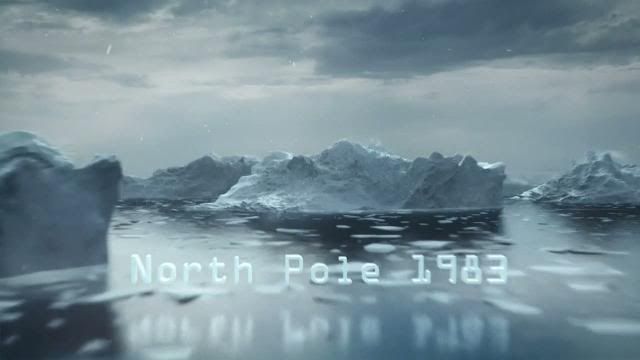
"Still water" is "Nature's Mirror." So what's under water here? What lies beneath the mirror?

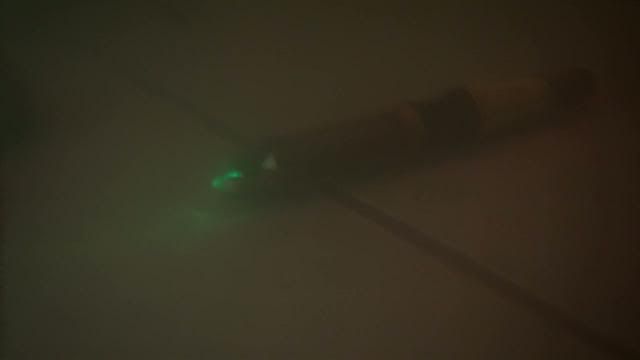

We get shots of three things below the surface of the mirror-like water. Which makes them "mirrors" of each other, in a sense. Of course there's the Submarine, which is surely the Whale of this tale. But inside the Sub, nested like Russian Matryoshka Dolls, we see the Sonic, very similar in shape...
...and Clara.
Now, both the Sub and the Sonic are eventually "invoked" as vehicles for "mutually assured destruction." So what does that make our newest Companion?
Perhaps we need to look at The Monster. The Monster in this case is an Ice Warrior, a creature from the planet Mars, named for the God of War. He is not an Ice Governess, made of ice, but hails from a land of ice and snow, and has suitably adapted to the cold. In this episode, he is introduced to us "alchemically" -- through a Union of Opposites.
A word on alchemy: it's the principle underlying Apotheosis and The Boon in the Heroic Journey, from which we gain both personal enlightenment and material social progress. We get many alchemical references in this story: The Captain says the ship's reactor has drowned, for example, an example of Fire + Water. The Doctor suggests Skaldar being out of his armor doesn't make him more vulnerable, but more dangerous; this is a union of opposites. When the dead crewmen are discovered, the Doctor says Skaldar isn't a savage, he's forensic (reversal) and that his "dismantling" uncovers our strengths and weaknesses (union); Skaldar is "dismantled" insofar as he's been stripped of his mantle, his outer casing.
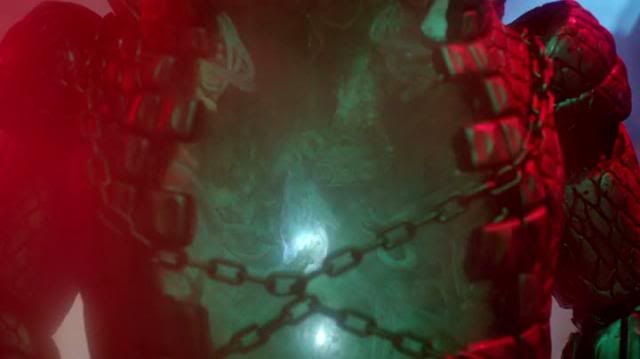
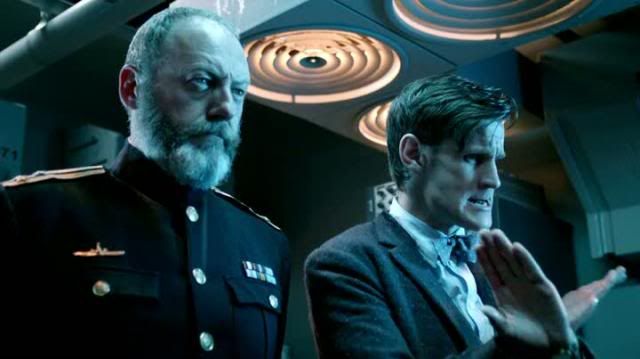
Thje "X" motif is another symbol of the alchemical process. Upon the Ice Warrior's armor it marks a reversal, along with the "decapitated" helmet: The Ice Warrior is free, more vulnerable and more dangerous; he is also, symbolically speaking, now like a Headless Monk.
The other instance of the X motif comes when the Doctor, who's been juxtaposed with Zhukov (they both smell like soldiers and refuse to let the other interrogate the Ice Warrior) uses reverse psychology on the Captain to get Clara in to question the monster herself.
A word on Zhukov. Zhukov is a name that derives from the Russian word for "beetle."The beetle was an important symbol in Ancient Egypt. Also referred to as the "scarab," it represented the ability to "come into being," a principle of transformation, and was often linked to the sun-god Khepri, who made the sun rise every day. This wasn't an arbitrary designation. Dung beetles were observed pushing rolled up pellets of dung, which the ancients likened to the sun. It's claimed they believed the beetles were exclusively male and "self-creating," that the dung-balls were in fact "eggs" rather than a food source for their broods.
Sorry about that digression. Names are important.
Finally, on the notion of "polarity", notice that both the Submarine and the Sonic look like "poles." Our story takes place at the North Pole, but the TARDIS relocates herself at the antipodes, at the South Pole: a Reversal of Polarity. Finally, the Professor has a cattle prod for the Polar Bears. It represents another fusion of Fire and Ice.
The cattle prod is used to render the Monster unconscious, which is the "second" time that's happened for Skaldar. The first happened five-thousand years ago, when he got Ambered -- that is, when he got locked in a block of ice, setting up his first "alchemical" rebirth -- a union of Fire and Ice:
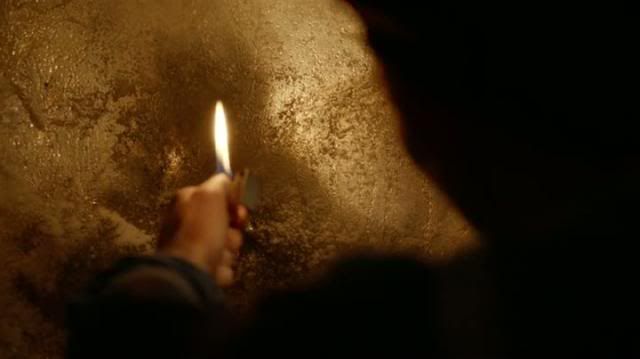
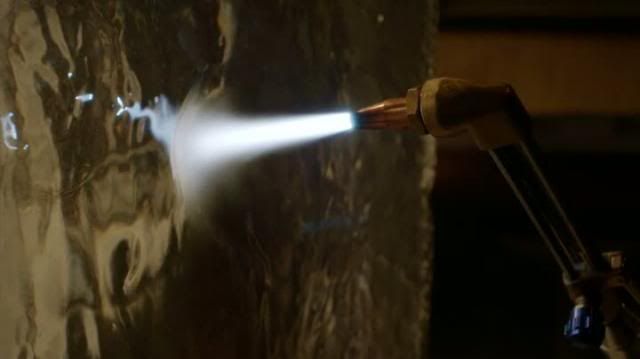
This juxtaposition of Fire and Ice reminds me of "Game of Thrones," the television adaptation of George R. R. Martin's A Song of Fire and Ice. Game of Thrones was invoked back at the Christmas special with the repetition of "winter is coming," one of the show's catchphrases. (Interestingly, the actress playing Clara is dating a Game of Thrones actor, and another GoT actor is featured in this episode: the man playing Captain Zhukov.)
Piotr, the man who sets the Ice Warrior free, is not played by a GoT actor, as far as I know. But before I forget: Names are Important! "Piotr" is the Russian variant of "Peter," which derives from the Greek petros which means "rock."
The most famous Peter is Saint Peter, one of Christ's disciples. Peter was originally Simon, a fisherman. He was the first of the disciples to recognize Christ's "true identity," and was accordingly was renamed Peter when Christ said, "Upon this Rock I shall build my Church." Peter was martyred upside-down, wanting not to die in the same manner as his Savior -- hence, the upside-down cross is considered a symbol of Peter. We see upside-down crosses holding the torches outside the monastery where the Doctor stays back in The Bells of Saint John.
Piotr, being the agent who releases the Ice Warrior and destabilizes the sub, is named ironically. But he isn't the one being alchemically juxtaposed with the Monster -- that distinction belongs to our heroes. It's accomplished through visual juxtaposition:
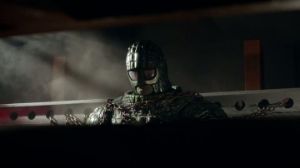
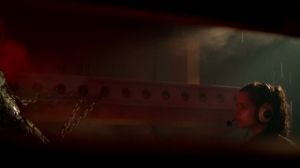
So too is the Doctor.
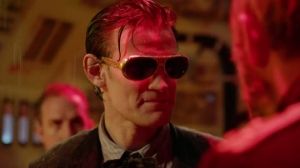
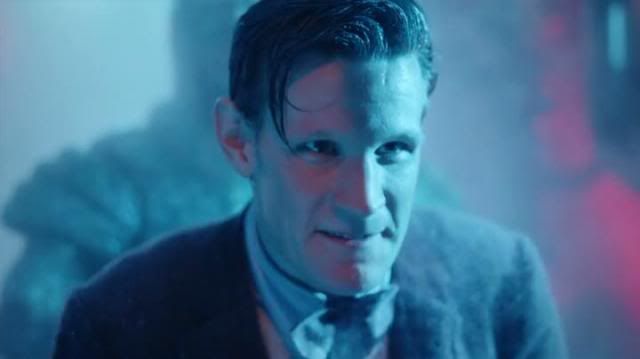
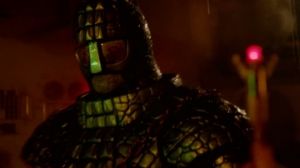
Doctor is shadowed by the Ice Warrior. And they both have Shades -- cool tinted eyewear. They will look each other in the eye at the end of the story to see who will "blink" first.
As is always the case, the Monster is a Mirror, a reflector of the darker impulses of humanity. It's true for Myths in general, and it's true for our characters as well.
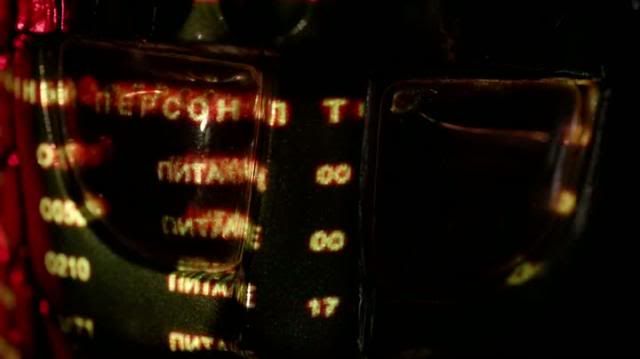
The aspect of the Monster as a representation of the Subconscious is often linked symbolically with the Moon, which is also a symbol of the Divine Feminine.
Mars has two moons, and they are invoked twice as "the Moons," once as a form of reverence ("by the Moons I honor thee") and once as a form of curse ("Harm one of us and you harm us all, by the Moons this I swear!") In both cases, though, the invocation of the Moons is one of sanctification.
So, about these moons. They're probably captured asteroids, and they are named mythologically. Ares (the Greek equivalent of Mars) bedded Aphrodite and they had twin sons, Deimos and Phobos, the "dread and terror" who followed their father, the god of war, into battle. The Doctor says that Skaldar is the vanquisher of "the Phobos Heresy" -- meaning that Skaldar has vanquished the heresy of Fear. Interesting that this is painted in religious terms.
Anyways, in a bit of self-referentiality, we see Clara and the Monster on an old black-and-white TV, harkening back to the Sixties, when the show was in black and white, when this monster was first introduced, and the kind of episode this is -- a "base under siege" -- was invented in the show and became a mainstay structure.
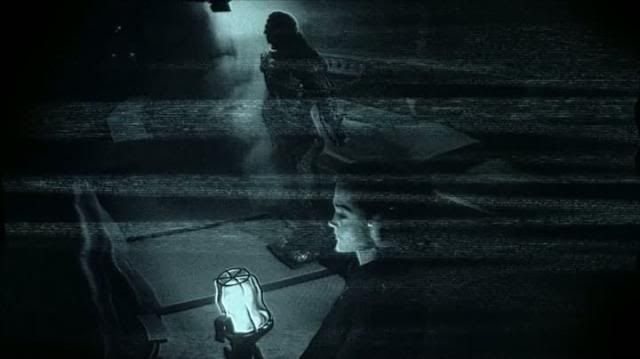
It's an interesting picture especially considering the bands of interference, which give the Monster a distinctly feminine shape. The juxtaposition of male and female is also alchemical -- which brings me back to the Monster's introduction, when Piotr first sets flame to ice.
Peter addresses the Monster as "milaya moya" -- which is not only to say "my sweet," but genders the warrior "female" in the process: it's "miliy moy" when spoken to a man.
Hello, sweetie!
The Woman Twice Dead
With Clara, we have a different take on the Heroic Journey. Clara is "The Woman Twice Dead." And Cold War tells a tale of Clara once again dying twice, and how this enables her to help save the world.
She emerges from the TARDIS expecting Las Vegas, a land that caters to the ego, to the worldly temptations of material existence. She's dressed in Silver, a mercurial element used to make mirrors. Even her shoes are sparkly silver, the color of Dorothy Gale's shoes in the original Wizard of Oz.
The Submarine -- as I said, the "Whale" of this fish story -- is already diving, without hope of rising back to the surface. The Doctor insists they make a Sideways maneuver, to an "anomaly" in the underwater geography, a ridge upon which they can rest. Being a fan of LOST, I can't help but think of the Sideways Universe, the final Other World of the Island where there is no Island, a place of Death.
But then the TARDIS disappears, the compartment starts flooding, and Clara is knocked underwater (along with the Sonic) where she's rendered unconscious.
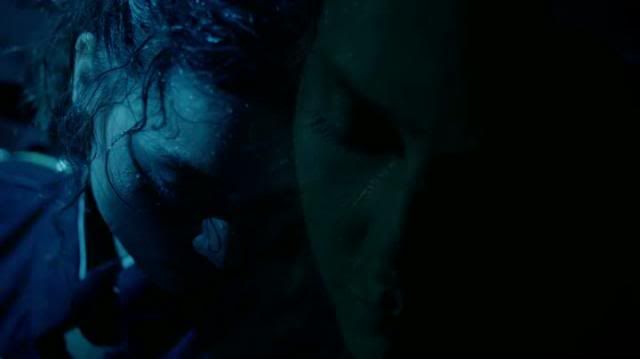
The first Death and Rebirth
In a symbolic death and rebirth (and notice the twinning in the shot, the superimposition) she awakens bathed in TARDIS blue light. She's wearing a Russian coat, which indicates an alchemical process has begun: Clara not only wears both Light and Dark clothes, but Male and Female clothes, Eastern and Western clothes, at once serious and frivolous, warrior and dancer.
She is a Lamb in Wolf's clothing. She doesn't smell of soldier -- it's not who she is -- but she can don the cloak of the role and step into the adventure. And she does. She enters the Belly of this whale, the Torpedo Room where the Ice Warrior has been chained to the rack bearing torpedoes -- at once both symbols of polarity (being poles) and masculinity, the prototypical phallic symbol.
She approaches the Empty Shell of the Ice Warrior, and they converse. He tells her a story.
SKALDAR: I was Fleet Commander of the Nix Tharsis. My daughter stood by me. It was her first taste of action. We sang the songs of the Old Times. The Songs of the Red Snow. Five thousand years... now my daughter will be dust! Only dust.
"Tharsis" is a transliteration of Tarshish, and was used to name a volcanic plateau on the planet Mars.
"Tarshish" is notable as part of the myth of Jonah and the Whale. Jonah was called by God to do a difficult task, to preach in the sinful city of Ninevah. Instead, he runs away to Tarshish, a far away place at the end of the world, proverbially speaking -- he takes a journey across the sea. A terrible storm threatens the ship, and the sailors learn by casting lots that Jonah's to blame; he's thrown overboard, and ends up in the belly of a whale, where he has time to reflect and finally repent; "reborn" in his spirit, he is disgorged and does what he is told.
The "Nix" in European folklore are shapeshifting water spirits, who try to lure mortals into the water to drown. They may appear as mermaids, merman, fish, even dragons or snakes. The Rheinmaidens of Wagner's Ring Cycle are nixies. So for Skaldar to be a part of the Nix Tharsis is to be alchemical -- to participate in both fire and water. And he is a shapeshifter, shedding his "skin" of armor to become quick and able to slip between the walls and floors of the ship. (Notice how he's becoming "polarized" in relation to Clara. Skaldar removes his warrior coat -- Clara has put one one.)
Perhaps Clara reminds him of his daughter when he tells her of the Songs of the Red Snow. Again we get an alchemical image, the fiery color of Red juxtaposed with the icy coldness of Snow. And, of course, we get the importance of Song here, too. It's a recurring theme -- the Ice Warrior with his sonic weapon, the Doctor with his drowned Sonic, and many references to music throughout the episode.

Puppet Clara, in Red
PROFESSOR: Courage, my dear. I always sing a song.
CLARA: What?
PROFESSOR: To keep my spirits up.
CLARA: Yes, that would work... if this was Pinocchio.
PROFESSOR: Do you know "Hungry Like The Wolf?"
Pinocchio is best remembered for his nose growing long (like a pole) whenever he lied. And there's quite a bit of reference to the importance of telling the truth in this story. The Doctor lies only once, to Clara, assuring her they'll be okay, but confesses when she challenges him on it. The rest of the time, "truth" is called for and referenced.
The Doctor tells the truth of being a time-traveler to the Captain. Skaldar wants to know if it's "true" he's slept for five millenia. Stepashin doesn't believe they're telling the truth; the Professor does, and calls it a "revolutionary" concept. Clara wants to know if it's "true" the Doctor's never seen a Martian outside its armor. A crewmember wants to know if it's "true" there's a Martian onboard. The Professor challenges Clara to prove it's "true" she's a time-traveler by telling him whether Ultravox splits up.
However, for our purposes, it might be more important to remember that Pinocchio is a "Belly of the Whale" story. In the original tale, the "monster" is a leviathan Shark/Dogfish hybrid, and the giant whale Monstro in the Disney movie. In both cases, this is where Pinocchio becomes a savior, rescuing his father from the beast. Having become a hero, which means giving up his ego for the sake of others, the Blue Fairy turns him into a "real boy."
PROFESSOR: I think he wants to speak to the organ-grinder, not to the monkey.
While Clara is speaking with Skaldar in the "belly of the whale," a torpedo room in the case a nuclear submarine, the professor suggests she's little more than a puppet for through which the Doctor speaks. Clara wears headphones (another sound reference) that connect her to the microphone and television where the Doctor sits, and she recites faithfully what he wants to say. This also harkens back to The Bells of Saint John, when the Doctor (as street magician rather than a musical organ-grinder) has Clara stick out the Fez hat to collect money for their breakfast.
Clara, by the way, is speaking to a "puppet" in the form of Skaldar's empty suit.
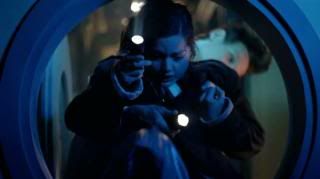
The second Death and Rebirth
When she discovers that Skaldar has left his shell, she races back to the hatchway from which she entered, and becomes paralyzed with fear. And again, she's bathed in the TARDIS-blue light. The Doctor rushes to the door and pulls her through, as if through a birth canal; recall the Huntsman who opens up the Wolf to save Little Red Riding Hood.
Clara has now symbolically died twice -- just like the Monster! Twice reborn, she can now process her experience.
"No creature can attain a higher grade of nature without ceasing to exist."
-- Ananda Coomaraswamy
Clara's first response is the response of Ego. She isn't concerned yet with the entailments of what's happened, only with her own personal consequences.
CLARA: Ha ha, I'm okay, I'm okay!
DOCTOR: Where did he go?
CLARA: How did I do? Was I okay?
DOCTOR: This wasn't a test, Clara.
Clara passed her tests back in Victorian London, when she found the One Word, and when she found The Ladder. Unfortunately she's forgotten all that -- which can happen when you die -- and the Doctor has to assure her she was great. "Really."
She then has the conversation with the Professor about Pinocchio and "singing a song" -- he's trying to help her get over her growing fear -- but she refuses to sing. She says it's something she'd do on "Hen Night" at a karaoke bar (both references go over the Professor's head) but she's too self-conscious to do so.
This is not the way of the hero path.
DOCTOR: By his own standards, Skaldak is a hero. It was said his enemies honoured him so much they'd carve his name into their own flesh before they died.
Quote:
The hero whose attachment to ego is already annihilate passes back and forth across the horizons of the world, in and out of the dragon, as readily as a king through all the rooms of his house. And therein lies his power to save; for his passing and returning demonstrate that through all the contraries and phenomenality the Uncreate-Imperishable remains, and there is nothing to fear.
And so it is that, throughout the world, men whose function is has been to make visible on earth the life-fructifying mystery of the slaying of the dragon have enacted upon their own bodies the great symbolic act, scattering their flesh, like the body of Osiris, for the renovation of the world.
-- Joseph Campbell, "The Belly of the Whale," Hero With a Thousand Faces
In another scene, we have two seamen who are looking for the Ice Warrior. They talk, shortly before the Alien creature will find them and kill them.
ONEGIN: If we get out of here, we'll be bloody heroes!
BELEVICH: If we get out of here.
ONEGIN: The first people in the world to discover a genuine, living... Alien?
Onegin is a made-up name by Alexander Pushkin, in his verse novel Eugene Onegin, yet another great work in Russian literature. The name itself suggests someone who is "from Lake Onega."
The book itself is a like a mirror. The characters profoundly reverse themselves -- the titular character going from icy cynic to someone sincerely passionate; the object of his love, upon Onegin's initial rejection of her advances, follows an opposite route. It's also suggested that the main character is a thinly veiled version of the author himself.
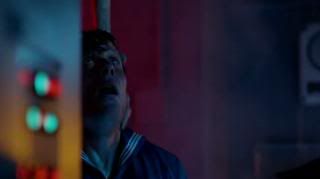
Anyways, the Onegin who dies here dies because he does not understand what it really means to be a hero. He imagines fame and glory at discovering an alien -- which is the concern of Ego. The heroic journey is about the annihilation of ego, of becoming self-less or "no self" in the Buddhist sense. The slaying of self confers oneness with all the world.
When the Doctor and Clara find their corpses, Clara reacts strongly. She starts to lose her will -- she meekly acquiesces to the Doctor's request she not wander off or follow him, to the Doctor's great surprise as he climbs a nearby Ladder.
After he's left, Clara eventually wanders over to the Ladder herself and reconsiders her ego-trip of facing off against Skaldar in the torpedo room. She says she's doing okay, still claims she's "chuffed," but she is not. That encounter (and her fear) pales in comparison to witnessing the deaths of these other men. It's the suffering of others that makes it "real" to Clara. And then the fear grows so much Clara starts to panic.
The music is weaving
Haunting notes, pizzicato strings
The rhythm is calling
Alone in the night as the daylight brings
A cool empty silence
The warmth of your hand and a cold gray sky
It fades to the distance
The image has gone only you and I
It means nothing to me
This means nothing to me
Oh, Vienna
-- Ultravox, "Vienna"
Again, it's up to the Professor to intervene. He trying to get her to talk about herself, but loses her voice -- she cannot answer the Professor's questions. It's as if she's forgotten who she is. It's only when the Professor gets into the time-travel stuff, and polishes off an aggressive line of questioning with joke about Ultravox (the "ultimate voice" and another musical reference) that Clara can laugh.
And then she's grabbed by the Alien, in a gesture reserved for the Egotistic. The Professor comes to her rescue, firing at the creature, and embodying the Warrior-Savior. When it's his turn to come into the Alien's grasp, it's Clara who rushes to his aid, no longer concerned for herself but for the man she's befriended. But when the Martian is threatened with more guns, he summons his Suit of Armor -- with his voice. Another sonic manifestation.
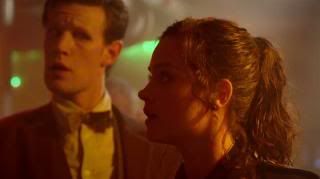
Savior Clara, in Golden tones
In the big climax, the alchemy of the story comes to full force. Deep beneath the Ice Fields of the North Pole, the Martian threatens to turn the planet Earth into a burning "red" cinder, which the Doctor ironically likens to "snuffing out the flame of a candle."
The Doctor and Skaldak face off "Eye To Eye" in a pose of mutually assured destruction (the Doctor once again was referred to as a mad-man earlier in the story) and this can only be an impasse, a matter of deciding "who will blink first." A game of chicken.
It's Clara who jumps into the fray with an answer.
CLARA: Why did you hesitate? Back there, in the dark. You were going to kill this man, remember? I begged you not to and you listened. Why show compassion then Skaldak and not now? The Doctor's right, billions will die: mothers, sons, fathers... daughters. Remember that last battle, Skaldak? Your daughter. You sang the Songs--
SKALDAK: --of the Red Snows.
She invokes the power of music, of memory, and of relationship. The Songs of the Red Snows -- songs of Alchemy.
And it is here that Salvation arrives, as if she has invoked it. Skaldak's people remember him. They have come for him. The submarine rises in the "astral light" of the Martian spaceship, and Gold's score invokes a motif from A Town Called Mercy.
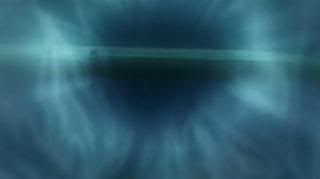
One of the visuals we get juxtaposes the sub with the tunnel of light, and in this particular shot the light is made to look like the iris of an Eye, another recurring motif of Moffat's run. And, as we discussed earlier, the submarine represents a "pole" -- but this is simply an axis mundi, another way of showing the The World Tree that connects the opposites, binding them together, and hence providing access between the Upper and Under worlds.
But they're not out of the woods yet. Just before Skaldak leaves, the Doctor begs him to "go in peace." Skaldak leaves, but the sub is still armed. The Doctor prays for Mercy. And then Clara actually sings: "Da da da da, I'm LOST and I'm found. And I'm hungry like the wolf."
For a second time, grace coincides with music, invoked by Clara.
The music is weaving
I smell like I sound. I'm lost and I'm found
And I'm hungry like the wolf
Strut on a line it's discord and rhyme
I'm on the hunt I'm after you
Mouth is alive with juices like wine
And I'm hungry like the wolf
-- Duran Duran, "Hungry Like the Wolf"
Speculation
So a few notes on what this might mean for understanding Clara.
At the beginning of this story, we saw Clara juxtaposed with both the Sonic and the Submarine. The Sonic makes sense now -- Clara used the power of Song to bring salvation to all concerned, and Music is obviously a huge theme running through the story -- two stories, now, actually.
But what of the submarine? What of the whale itself?
Names are important. This submarine is named Firebird. It is alchemical, a union of Fire+Water. And it is Mythic. The firebird is the Phoenix, a mythological creature that is cyclically reborn, rising from its own ashes. It is analogous to the Sun, representing the principle of Resurrection.
Igor Stravinsky got his big break writing the score to the ballet The Firebird. The ballet itself is a fusion of two different Russian folktales, the myth of the Firebird itself, which is a blessing and a curse to those who capture it, and the myth of Kaschei the Immortal. The story goes like this: Prince Ivan wanders into Kaschei's magical realm and captures a Firebird, who sends the Immortal One and all in his domain (including some thirteen princesses, one of whom Ivan's fallen in love with) into a frenzied Infernal Dance, tiring them out and making them fall asleep. But Kaschei, being immortal, quickly recovers and must be enchanted again -- he represents the principle of resurrection. To defeat him, the Firebird directs Ivan to a magical egg, which contains Kaschei's soul. Ivan break the egg, killing Kaschei -- and all the magical creatures of the realm, including the firebird. The princesses, however, were always real, and Ivan can now marry his true love.
So there's a musical reference as well! Some have speculated that Clara is an "egg" -- all those "egg" references back in the Fall. I'm beginning to believe myself.
Okay, look at this juxtaposition:
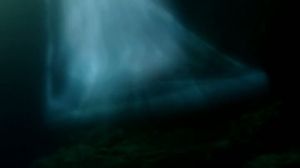
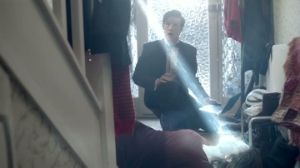
The silvery light of Ascension, of Rebirth, on both Clara and the Firebird. Clara *is* the firebird. She is the one who Ascends.
Here's another suggestion that Clara might be a Vehicle for Ascension:
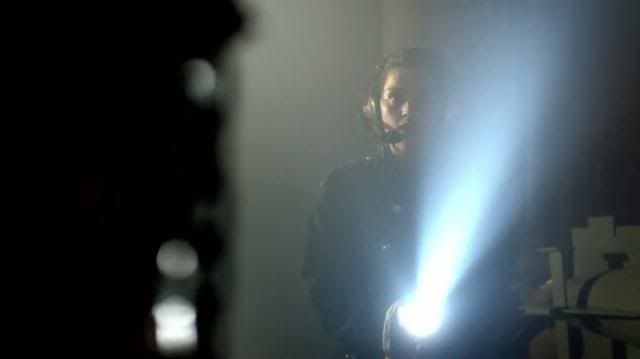
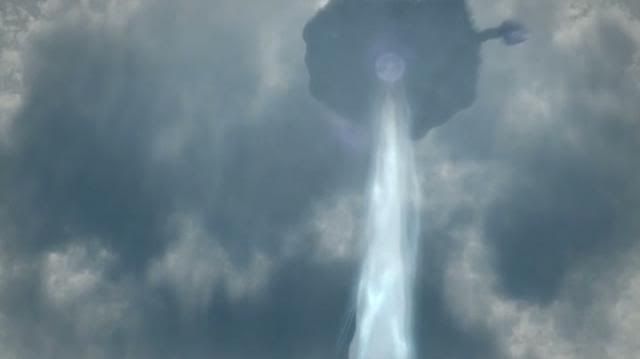
Which implies that Clara is her own means of Ascension.
Finally, I'd like to note this story completely fails the Bechdel test. There's only one female character in the whole story. I find it curious, however, that in a story where Pinocchio is invoked, Clara plays "a puppet" early on, who in a moment of existential crisis nearly forgets who she is. This has been a running theme for Clara -- she doesn't know she's a Dalek in the Asylum, she doesn't know she's The Woman Twice Dead, doesn't realize she's become a computer wizard until the Doctor points it out.
In the Pinocchio story, the puppet is made "real" by the magic of the Blue Fairy. But in a story with only one woman, who can possibly be Clara's TARDIS-Blue Fairy?
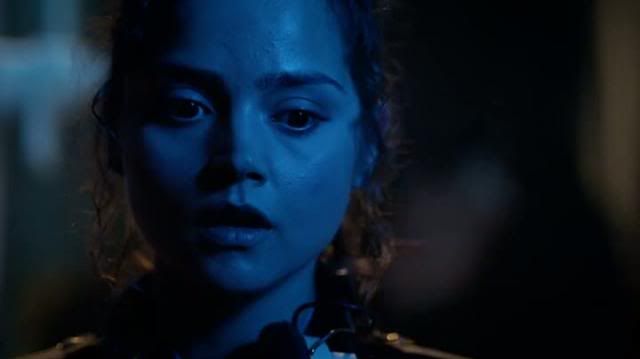
ROSE: I am the Bad Wolf. I create myself.

I wonder if Clara is an Artificial Intelligence, a monster designed to trap the Doctor.
But in the interim, is she trying to become A Real Girl?

The Doctor's Kiss
Thank you for reading!
spoilers through the episode
+ speculation
a very long post
Dive below the surface....
The Belly of the Whale...
So, in many ancient myths there's the motif of being swallowed by a giant monster -- a shark, a whale, what have you -- and how that experience becomes transformative for the hero of the tale.
Red Riding Hood, for example, is swallowed by a wolf, and her emergence from that beast marks the end of her innocence; her red hood or cap refer both to the onset of menstruation and the setting and rising of the sun. In Norse mythology, the wolf Sköll will swallow the sun during Ragnarök, the end of the world. (Sköll is the son of the monstrous wolf Fenrir, himself the son of the trickster god Loki, who will slay Odin.)
ZHUKOV: What is it? A mammoth?
PROFESSOR: Probably.
The Zulus have a story about a poor but confident woman (her hut sits in the middle of the road) whose children get eaten by an enormous elephant. She finds the elephant and is swallowed herself. Inside the elephant is an entire world -- a forest, rivers, a high plateau, and even a village where people had built a village, for the elephant had swallowed many people. But no one there would eat the elephant from the inside, afraid it would die and kill them. The confident woman says only the beast will die, not themselves. And so they eat the beast, and cut their way out, and the confident woman is hailed as a hero, and is bequeathed many gifts from the grateful people she saved.
The hero already possesses the qualities they need, it's only a matter of "cutting them out" for them to become manifest. All it takes is "death and rebirth."

"Still water" is "Nature's Mirror." So what's under water here? What lies beneath the mirror?



We get shots of three things below the surface of the mirror-like water. Which makes them "mirrors" of each other, in a sense. Of course there's the Submarine, which is surely the Whale of this tale. But inside the Sub, nested like Russian Matryoshka Dolls, we see the Sonic, very similar in shape...
...and Clara.
Now, both the Sub and the Sonic are eventually "invoked" as vehicles for "mutually assured destruction." So what does that make our newest Companion?
Perhaps we need to look at The Monster. The Monster in this case is an Ice Warrior, a creature from the planet Mars, named for the God of War. He is not an Ice Governess, made of ice, but hails from a land of ice and snow, and has suitably adapted to the cold. In this episode, he is introduced to us "alchemically" -- through a Union of Opposites.
A word on alchemy: it's the principle underlying Apotheosis and The Boon in the Heroic Journey, from which we gain both personal enlightenment and material social progress. We get many alchemical references in this story: The Captain says the ship's reactor has drowned, for example, an example of Fire + Water. The Doctor suggests Skaldar being out of his armor doesn't make him more vulnerable, but more dangerous; this is a union of opposites. When the dead crewmen are discovered, the Doctor says Skaldar isn't a savage, he's forensic (reversal) and that his "dismantling" uncovers our strengths and weaknesses (union); Skaldar is "dismantled" insofar as he's been stripped of his mantle, his outer casing.


Thje "X" motif is another symbol of the alchemical process. Upon the Ice Warrior's armor it marks a reversal, along with the "decapitated" helmet: The Ice Warrior is free, more vulnerable and more dangerous; he is also, symbolically speaking, now like a Headless Monk.
The other instance of the X motif comes when the Doctor, who's been juxtaposed with Zhukov (they both smell like soldiers and refuse to let the other interrogate the Ice Warrior) uses reverse psychology on the Captain to get Clara in to question the monster herself.
A word on Zhukov. Zhukov is a name that derives from the Russian word for "beetle."The beetle was an important symbol in Ancient Egypt. Also referred to as the "scarab," it represented the ability to "come into being," a principle of transformation, and was often linked to the sun-god Khepri, who made the sun rise every day. This wasn't an arbitrary designation. Dung beetles were observed pushing rolled up pellets of dung, which the ancients likened to the sun. It's claimed they believed the beetles were exclusively male and "self-creating," that the dung-balls were in fact "eggs" rather than a food source for their broods.
Sorry about that digression. Names are important.
Finally, on the notion of "polarity", notice that both the Submarine and the Sonic look like "poles." Our story takes place at the North Pole, but the TARDIS relocates herself at the antipodes, at the South Pole: a Reversal of Polarity. Finally, the Professor has a cattle prod for the Polar Bears. It represents another fusion of Fire and Ice.
The cattle prod is used to render the Monster unconscious, which is the "second" time that's happened for Skaldar. The first happened five-thousand years ago, when he got Ambered -- that is, when he got locked in a block of ice, setting up his first "alchemical" rebirth -- a union of Fire and Ice:


This juxtaposition of Fire and Ice reminds me of "Game of Thrones," the television adaptation of George R. R. Martin's A Song of Fire and Ice. Game of Thrones was invoked back at the Christmas special with the repetition of "winter is coming," one of the show's catchphrases. (Interestingly, the actress playing Clara is dating a Game of Thrones actor, and another GoT actor is featured in this episode: the man playing Captain Zhukov.)
Piotr, the man who sets the Ice Warrior free, is not played by a GoT actor, as far as I know. But before I forget: Names are Important! "Piotr" is the Russian variant of "Peter," which derives from the Greek petros which means "rock."
The most famous Peter is Saint Peter, one of Christ's disciples. Peter was originally Simon, a fisherman. He was the first of the disciples to recognize Christ's "true identity," and was accordingly was renamed Peter when Christ said, "Upon this Rock I shall build my Church." Peter was martyred upside-down, wanting not to die in the same manner as his Savior -- hence, the upside-down cross is considered a symbol of Peter. We see upside-down crosses holding the torches outside the monastery where the Doctor stays back in The Bells of Saint John.
Piotr, being the agent who releases the Ice Warrior and destabilizes the sub, is named ironically. But he isn't the one being alchemically juxtaposed with the Monster -- that distinction belongs to our heroes. It's accomplished through visual juxtaposition:


So too is the Doctor.



Doctor is shadowed by the Ice Warrior. And they both have Shades -- cool tinted eyewear. They will look each other in the eye at the end of the story to see who will "blink" first.
As is always the case, the Monster is a Mirror, a reflector of the darker impulses of humanity. It's true for Myths in general, and it's true for our characters as well.

The aspect of the Monster as a representation of the Subconscious is often linked symbolically with the Moon, which is also a symbol of the Divine Feminine.
Mars has two moons, and they are invoked twice as "the Moons," once as a form of reverence ("by the Moons I honor thee") and once as a form of curse ("Harm one of us and you harm us all, by the Moons this I swear!") In both cases, though, the invocation of the Moons is one of sanctification.
So, about these moons. They're probably captured asteroids, and they are named mythologically. Ares (the Greek equivalent of Mars) bedded Aphrodite and they had twin sons, Deimos and Phobos, the "dread and terror" who followed their father, the god of war, into battle. The Doctor says that Skaldar is the vanquisher of "the Phobos Heresy" -- meaning that Skaldar has vanquished the heresy of Fear. Interesting that this is painted in religious terms.
Anyways, in a bit of self-referentiality, we see Clara and the Monster on an old black-and-white TV, harkening back to the Sixties, when the show was in black and white, when this monster was first introduced, and the kind of episode this is -- a "base under siege" -- was invented in the show and became a mainstay structure.

It's an interesting picture especially considering the bands of interference, which give the Monster a distinctly feminine shape. The juxtaposition of male and female is also alchemical -- which brings me back to the Monster's introduction, when Piotr first sets flame to ice.
Peter addresses the Monster as "milaya moya" -- which is not only to say "my sweet," but genders the warrior "female" in the process: it's "miliy moy" when spoken to a man.
Hello, sweetie!
The Woman Twice Dead
With Clara, we have a different take on the Heroic Journey. Clara is "The Woman Twice Dead." And Cold War tells a tale of Clara once again dying twice, and how this enables her to help save the world.
She emerges from the TARDIS expecting Las Vegas, a land that caters to the ego, to the worldly temptations of material existence. She's dressed in Silver, a mercurial element used to make mirrors. Even her shoes are sparkly silver, the color of Dorothy Gale's shoes in the original Wizard of Oz.
The Submarine -- as I said, the "Whale" of this fish story -- is already diving, without hope of rising back to the surface. The Doctor insists they make a Sideways maneuver, to an "anomaly" in the underwater geography, a ridge upon which they can rest. Being a fan of LOST, I can't help but think of the Sideways Universe, the final Other World of the Island where there is no Island, a place of Death.
But then the TARDIS disappears, the compartment starts flooding, and Clara is knocked underwater (along with the Sonic) where she's rendered unconscious.

The first Death and Rebirth
In a symbolic death and rebirth (and notice the twinning in the shot, the superimposition) she awakens bathed in TARDIS blue light. She's wearing a Russian coat, which indicates an alchemical process has begun: Clara not only wears both Light and Dark clothes, but Male and Female clothes, Eastern and Western clothes, at once serious and frivolous, warrior and dancer.
She is a Lamb in Wolf's clothing. She doesn't smell of soldier -- it's not who she is -- but she can don the cloak of the role and step into the adventure. And she does. She enters the Belly of this whale, the Torpedo Room where the Ice Warrior has been chained to the rack bearing torpedoes -- at once both symbols of polarity (being poles) and masculinity, the prototypical phallic symbol.
She approaches the Empty Shell of the Ice Warrior, and they converse. He tells her a story.
SKALDAR: I was Fleet Commander of the Nix Tharsis. My daughter stood by me. It was her first taste of action. We sang the songs of the Old Times. The Songs of the Red Snow. Five thousand years... now my daughter will be dust! Only dust.
"Tharsis" is a transliteration of Tarshish, and was used to name a volcanic plateau on the planet Mars.
"Tarshish" is notable as part of the myth of Jonah and the Whale. Jonah was called by God to do a difficult task, to preach in the sinful city of Ninevah. Instead, he runs away to Tarshish, a far away place at the end of the world, proverbially speaking -- he takes a journey across the sea. A terrible storm threatens the ship, and the sailors learn by casting lots that Jonah's to blame; he's thrown overboard, and ends up in the belly of a whale, where he has time to reflect and finally repent; "reborn" in his spirit, he is disgorged and does what he is told.
The "Nix" in European folklore are shapeshifting water spirits, who try to lure mortals into the water to drown. They may appear as mermaids, merman, fish, even dragons or snakes. The Rheinmaidens of Wagner's Ring Cycle are nixies. So for Skaldar to be a part of the Nix Tharsis is to be alchemical -- to participate in both fire and water. And he is a shapeshifter, shedding his "skin" of armor to become quick and able to slip between the walls and floors of the ship. (Notice how he's becoming "polarized" in relation to Clara. Skaldar removes his warrior coat -- Clara has put one one.)
Perhaps Clara reminds him of his daughter when he tells her of the Songs of the Red Snow. Again we get an alchemical image, the fiery color of Red juxtaposed with the icy coldness of Snow. And, of course, we get the importance of Song here, too. It's a recurring theme -- the Ice Warrior with his sonic weapon, the Doctor with his drowned Sonic, and many references to music throughout the episode.

Puppet Clara, in Red
PROFESSOR: Courage, my dear. I always sing a song.
CLARA: What?
PROFESSOR: To keep my spirits up.
CLARA: Yes, that would work... if this was Pinocchio.
PROFESSOR: Do you know "Hungry Like The Wolf?"
Pinocchio is best remembered for his nose growing long (like a pole) whenever he lied. And there's quite a bit of reference to the importance of telling the truth in this story. The Doctor lies only once, to Clara, assuring her they'll be okay, but confesses when she challenges him on it. The rest of the time, "truth" is called for and referenced.
The Doctor tells the truth of being a time-traveler to the Captain. Skaldar wants to know if it's "true" he's slept for five millenia. Stepashin doesn't believe they're telling the truth; the Professor does, and calls it a "revolutionary" concept. Clara wants to know if it's "true" the Doctor's never seen a Martian outside its armor. A crewmember wants to know if it's "true" there's a Martian onboard. The Professor challenges Clara to prove it's "true" she's a time-traveler by telling him whether Ultravox splits up.
However, for our purposes, it might be more important to remember that Pinocchio is a "Belly of the Whale" story. In the original tale, the "monster" is a leviathan Shark/Dogfish hybrid, and the giant whale Monstro in the Disney movie. In both cases, this is where Pinocchio becomes a savior, rescuing his father from the beast. Having become a hero, which means giving up his ego for the sake of others, the Blue Fairy turns him into a "real boy."
PROFESSOR: I think he wants to speak to the organ-grinder, not to the monkey.
While Clara is speaking with Skaldar in the "belly of the whale," a torpedo room in the case a nuclear submarine, the professor suggests she's little more than a puppet for through which the Doctor speaks. Clara wears headphones (another sound reference) that connect her to the microphone and television where the Doctor sits, and she recites faithfully what he wants to say. This also harkens back to The Bells of Saint John, when the Doctor (as street magician rather than a musical organ-grinder) has Clara stick out the Fez hat to collect money for their breakfast.
Clara, by the way, is speaking to a "puppet" in the form of Skaldar's empty suit.

The second Death and Rebirth
When she discovers that Skaldar has left his shell, she races back to the hatchway from which she entered, and becomes paralyzed with fear. And again, she's bathed in the TARDIS-blue light. The Doctor rushes to the door and pulls her through, as if through a birth canal; recall the Huntsman who opens up the Wolf to save Little Red Riding Hood.
Clara has now symbolically died twice -- just like the Monster! Twice reborn, she can now process her experience.
"No creature can attain a higher grade of nature without ceasing to exist."
-- Ananda Coomaraswamy
Clara's first response is the response of Ego. She isn't concerned yet with the entailments of what's happened, only with her own personal consequences.
CLARA: Ha ha, I'm okay, I'm okay!
DOCTOR: Where did he go?
CLARA: How did I do? Was I okay?
DOCTOR: This wasn't a test, Clara.
Clara passed her tests back in Victorian London, when she found the One Word, and when she found The Ladder. Unfortunately she's forgotten all that -- which can happen when you die -- and the Doctor has to assure her she was great. "Really."
She then has the conversation with the Professor about Pinocchio and "singing a song" -- he's trying to help her get over her growing fear -- but she refuses to sing. She says it's something she'd do on "Hen Night" at a karaoke bar (both references go over the Professor's head) but she's too self-conscious to do so.
This is not the way of the hero path.
DOCTOR: By his own standards, Skaldak is a hero. It was said his enemies honoured him so much they'd carve his name into their own flesh before they died.
Quote:
The hero whose attachment to ego is already annihilate passes back and forth across the horizons of the world, in and out of the dragon, as readily as a king through all the rooms of his house. And therein lies his power to save; for his passing and returning demonstrate that through all the contraries and phenomenality the Uncreate-Imperishable remains, and there is nothing to fear.
And so it is that, throughout the world, men whose function is has been to make visible on earth the life-fructifying mystery of the slaying of the dragon have enacted upon their own bodies the great symbolic act, scattering their flesh, like the body of Osiris, for the renovation of the world.
-- Joseph Campbell, "The Belly of the Whale," Hero With a Thousand Faces
In another scene, we have two seamen who are looking for the Ice Warrior. They talk, shortly before the Alien creature will find them and kill them.
ONEGIN: If we get out of here, we'll be bloody heroes!
BELEVICH: If we get out of here.
ONEGIN: The first people in the world to discover a genuine, living... Alien?
Onegin is a made-up name by Alexander Pushkin, in his verse novel Eugene Onegin, yet another great work in Russian literature. The name itself suggests someone who is "from Lake Onega."
The book itself is a like a mirror. The characters profoundly reverse themselves -- the titular character going from icy cynic to someone sincerely passionate; the object of his love, upon Onegin's initial rejection of her advances, follows an opposite route. It's also suggested that the main character is a thinly veiled version of the author himself.

Anyways, the Onegin who dies here dies because he does not understand what it really means to be a hero. He imagines fame and glory at discovering an alien -- which is the concern of Ego. The heroic journey is about the annihilation of ego, of becoming self-less or "no self" in the Buddhist sense. The slaying of self confers oneness with all the world.
When the Doctor and Clara find their corpses, Clara reacts strongly. She starts to lose her will -- she meekly acquiesces to the Doctor's request she not wander off or follow him, to the Doctor's great surprise as he climbs a nearby Ladder.
After he's left, Clara eventually wanders over to the Ladder herself and reconsiders her ego-trip of facing off against Skaldar in the torpedo room. She says she's doing okay, still claims she's "chuffed," but she is not. That encounter (and her fear) pales in comparison to witnessing the deaths of these other men. It's the suffering of others that makes it "real" to Clara. And then the fear grows so much Clara starts to panic.
The music is weaving
Haunting notes, pizzicato strings
The rhythm is calling
Alone in the night as the daylight brings
A cool empty silence
The warmth of your hand and a cold gray sky
It fades to the distance
The image has gone only you and I
It means nothing to me
This means nothing to me
Oh, Vienna
-- Ultravox, "Vienna"
Again, it's up to the Professor to intervene. He trying to get her to talk about herself, but loses her voice -- she cannot answer the Professor's questions. It's as if she's forgotten who she is. It's only when the Professor gets into the time-travel stuff, and polishes off an aggressive line of questioning with joke about Ultravox (the "ultimate voice" and another musical reference) that Clara can laugh.
And then she's grabbed by the Alien, in a gesture reserved for the Egotistic. The Professor comes to her rescue, firing at the creature, and embodying the Warrior-Savior. When it's his turn to come into the Alien's grasp, it's Clara who rushes to his aid, no longer concerned for herself but for the man she's befriended. But when the Martian is threatened with more guns, he summons his Suit of Armor -- with his voice. Another sonic manifestation.

Savior Clara, in Golden tones
In the big climax, the alchemy of the story comes to full force. Deep beneath the Ice Fields of the North Pole, the Martian threatens to turn the planet Earth into a burning "red" cinder, which the Doctor ironically likens to "snuffing out the flame of a candle."
The Doctor and Skaldak face off "Eye To Eye" in a pose of mutually assured destruction (the Doctor once again was referred to as a mad-man earlier in the story) and this can only be an impasse, a matter of deciding "who will blink first." A game of chicken.
It's Clara who jumps into the fray with an answer.
CLARA: Why did you hesitate? Back there, in the dark. You were going to kill this man, remember? I begged you not to and you listened. Why show compassion then Skaldak and not now? The Doctor's right, billions will die: mothers, sons, fathers... daughters. Remember that last battle, Skaldak? Your daughter. You sang the Songs--
SKALDAK: --of the Red Snows.
She invokes the power of music, of memory, and of relationship. The Songs of the Red Snows -- songs of Alchemy.
And it is here that Salvation arrives, as if she has invoked it. Skaldak's people remember him. They have come for him. The submarine rises in the "astral light" of the Martian spaceship, and Gold's score invokes a motif from A Town Called Mercy.

One of the visuals we get juxtaposes the sub with the tunnel of light, and in this particular shot the light is made to look like the iris of an Eye, another recurring motif of Moffat's run. And, as we discussed earlier, the submarine represents a "pole" -- but this is simply an axis mundi, another way of showing the The World Tree that connects the opposites, binding them together, and hence providing access between the Upper and Under worlds.
But they're not out of the woods yet. Just before Skaldak leaves, the Doctor begs him to "go in peace." Skaldak leaves, but the sub is still armed. The Doctor prays for Mercy. And then Clara actually sings: "Da da da da, I'm LOST and I'm found. And I'm hungry like the wolf."
For a second time, grace coincides with music, invoked by Clara.
The music is weaving
I smell like I sound. I'm lost and I'm found
And I'm hungry like the wolf
Strut on a line it's discord and rhyme
I'm on the hunt I'm after you
Mouth is alive with juices like wine
And I'm hungry like the wolf
-- Duran Duran, "Hungry Like the Wolf"
Speculation
So a few notes on what this might mean for understanding Clara.
At the beginning of this story, we saw Clara juxtaposed with both the Sonic and the Submarine. The Sonic makes sense now -- Clara used the power of Song to bring salvation to all concerned, and Music is obviously a huge theme running through the story -- two stories, now, actually.
But what of the submarine? What of the whale itself?
Names are important. This submarine is named Firebird. It is alchemical, a union of Fire+Water. And it is Mythic. The firebird is the Phoenix, a mythological creature that is cyclically reborn, rising from its own ashes. It is analogous to the Sun, representing the principle of Resurrection.
Igor Stravinsky got his big break writing the score to the ballet The Firebird. The ballet itself is a fusion of two different Russian folktales, the myth of the Firebird itself, which is a blessing and a curse to those who capture it, and the myth of Kaschei the Immortal. The story goes like this: Prince Ivan wanders into Kaschei's magical realm and captures a Firebird, who sends the Immortal One and all in his domain (including some thirteen princesses, one of whom Ivan's fallen in love with) into a frenzied Infernal Dance, tiring them out and making them fall asleep. But Kaschei, being immortal, quickly recovers and must be enchanted again -- he represents the principle of resurrection. To defeat him, the Firebird directs Ivan to a magical egg, which contains Kaschei's soul. Ivan break the egg, killing Kaschei -- and all the magical creatures of the realm, including the firebird. The princesses, however, were always real, and Ivan can now marry his true love.
So there's a musical reference as well! Some have speculated that Clara is an "egg" -- all those "egg" references back in the Fall. I'm beginning to believe myself.
Okay, look at this juxtaposition:


The silvery light of Ascension, of Rebirth, on both Clara and the Firebird. Clara *is* the firebird. She is the one who Ascends.
Here's another suggestion that Clara might be a Vehicle for Ascension:


Which implies that Clara is her own means of Ascension.
Finally, I'd like to note this story completely fails the Bechdel test. There's only one female character in the whole story. I find it curious, however, that in a story where Pinocchio is invoked, Clara plays "a puppet" early on, who in a moment of existential crisis nearly forgets who she is. This has been a running theme for Clara -- she doesn't know she's a Dalek in the Asylum, she doesn't know she's The Woman Twice Dead, doesn't realize she's become a computer wizard until the Doctor points it out.
In the Pinocchio story, the puppet is made "real" by the magic of the Blue Fairy. But in a story with only one woman, who can possibly be Clara's TARDIS-Blue Fairy?

ROSE: I am the Bad Wolf. I create myself.

I wonder if Clara is an Artificial Intelligence, a monster designed to trap the Doctor.
But in the interim, is she trying to become A Real Girl?

The Doctor's Kiss
Thank you for reading!